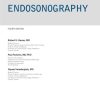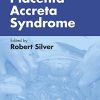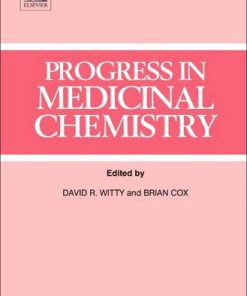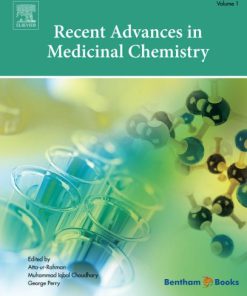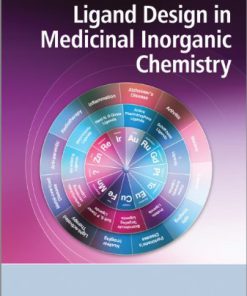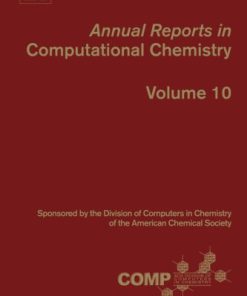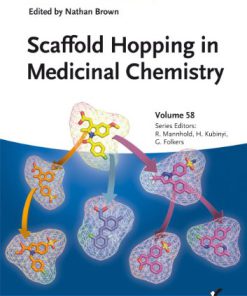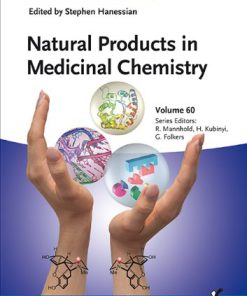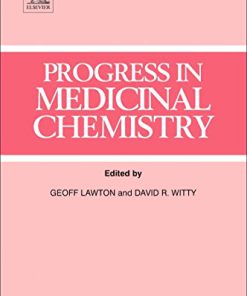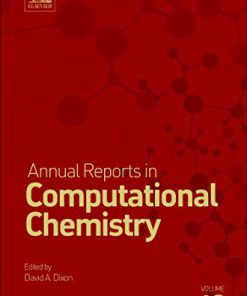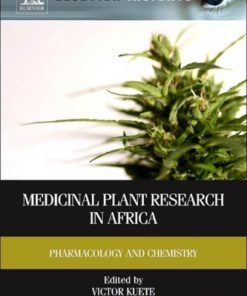Annual Reports in Medicinal Chemistry 1st Edition by Desai Desai 0124171503 9780124171503
$50.00 Original price was: $50.00.$25.00Current price is: $25.00.
Annual Reports in Medicinal Chemistry 1st Edition by Desai C Desai – Ebook PDF Instant Download/DeliveryISBN: 0124171503, 9780124171503
Full download Annual Reports in Medicinal Chemistry 1st Edition after payment.
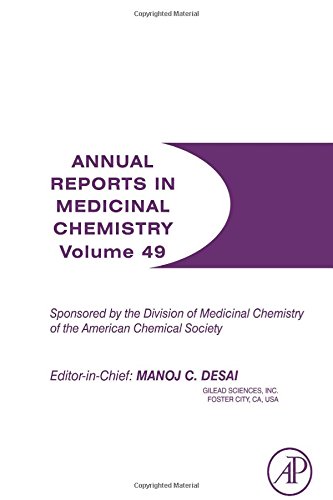
Product details:
ISBN-10 : 0124171503
ISBN-13 : 9780124171503
Author: Desai C Desai
Annual Reports in Medicinal Chemistry provides timely and critical reviews of important topics in medicinal chemistry together with an emphasis on emerging topics in the biological sciences, which are expected to provide the basis for entirely new future therapies.
Annual Reports in Medicinal Chemistry provides timely and critical reviews and this volume covers a important topics such as drug Discovery, Idiopathic Pulmonary Fibrosis and Neuraminidase Inhibitors
Annual Reports in Medicinal Chemistry 1st Table of contents:
Chapter One: Challenges in Drug Discovery at Schering-Plough Research Institute: A Personal Reflecti
Acknowledgments
References
Chapter Two: My Perspective on Time, Managers-and Scientific Fun
1. Controlling Your Scientific Life: Time Management
2. Foster Innovation with Scientific Fun
3. A Good Manager is a Scientist’s Best Friend
References
Chapter Three: A Career in Medicinal Chemistry-A Journey in Drug Discovery
1. Early Days in Nucleoside, Nucleotide, and Nucleic Acid Chemistry
2. Antivirals
3. Elastase Inhibitors
4. Substance P Antagonists and the Discovery of Aprepitant and Fosaprepitant
5. Hypoglycemic Agents and the Discovery of Sitagliptin
6. Conclusions
References
Section 1: Central Nervous System Diseases
Chapter Four: Selective Inhibitors of PDE2, PDE9, and PDE10: Modulators of Activity of the Central N
1. Introduction
2. Phosphodiesterase (PDE) Structures
2.1. Phosphodiesterase 9 (PDE9) structure
2.2. Phosphodiesterase 10 (PDE10) structure
2.3. Phosphodiesterase 2 (PDE2) structure
3. PDE2 Inhibitors and Dual PDE2+PDE10 Inhibitors
4. PDE9 Inhibitors
5. PDE10 Inhibitors
6. Conclusions
References
Chapter Five: Beyond Secretases: Kinase Inhibitors for the Treatment of Alzheimer’s Disease
1. Introduction
2. Inhibitors of Dual-Specificity Kinases
2.1. DYRK1A inhibitors
3. Inhibitors of Serine-Threonine Kinases
3.1. GSK-3β inhibitors
3.2. CDK5/p25 inhibitors
3.3. ERK2 inhibitors
3.4. JNK3 inhibitors
3.5. Casein kinase-1 inhibitors
3.6. Inhibitors of ROCK kinase
4. Conclusions
References
Chapter Six: Orexin Receptor Antagonists in Development for Insomnia and CNS Disorders
1. Introduction
2. Clinical Programs
3. Preclinical Programs
4. Potential Indications Beyond Sleep
5. Concluding Remarks
References
Section 2: Cardiovascular and Metabolic Diseases
Chapter Seven: Discovery and Development of Prolylcarboxypeptidase Inhibitors for Cardiometabolic Di
1. Introduction
2. PRCP Function and Structure
3. PRCP: Peptide Processing and Regulation
3.1. The renin-angiotensin system
3.2. The kallikrein-kinin system
3.3. α-Melanocyte stimulating hormone
4. PRCP Inhibitors as Antiobesity Agents
5. Conclusions
References
Chapter Eight: Molecular Targeting of Imaging and Drug Delivery Probes in Atherosclerosis
1. Introduction
2. Chemical and Imaging Approaches
3. Targeting of Vascular Adhesion Molecules and Markers of Inflammation
4. Conclusions
References
Chapter Nine: Oral GLP-1 Modulators for the Treatment of Diabetes
1. Introduction
2. Formulation of Peptidic Agonists
3. Active Transport of Peptidic Agonists
4. Small Molecule Agonists of the GLP-1R
5. Conclusion
References
Section 3: Inflammation Pulmonary GI Diseases
Chapter Ten: Recent Advances in the Discovery and Development of CCR1 Antagonists
1. Introduction
1.1. CCR1 and its chemokine ligands
1.2. Clinical relevance and potential therapeutic indications
2. Small Molecule CCR1 Antagonists
2.1. Early compounds
2.2. Recently published/disclosed compounds
3. Clinical Update
4. Outlook
References
Chapter Eleven: Emerging Targets for the Treatment of Idiopathic Pulmonary Fibrosis
1. Introduction
1.1. Idiopathic pulmonary fibrosis (IPF)
1.2. Current treatment options
2. G Protein-Coupled Receptors (GPCRs)
2.1. CXCR4
2.2. RXFP1
3. Extracellular Crosslinking Enzymes
3.1. Transglutaminase 2 (TG2)
4. Kinase Inhibitors
4.1. Focal adhesion kinase (FAK) inhibitors
4.2. Phosphatidylinositol 3-kinase (PI3K) inhibitors
5. Enzymes
5.1. NADPH oxidase 4 (NOX4) inhibitors
5.2. Galectin-3 inhibitors
6. Lysophospholipid Mediators
6.1. Lysophosphatidic acid receptor-1 antagonists
7. Conclusions
References
Chapter Twelve: Targeting the Nuclear Hormone Receptor RORγt for the Treatment of Autoimmune and In
1. Introduction
1.1. ROR family of nuclear hormone receptors
1.2. RORγt and Th17 cells
1.3. RORγt+ innate lymphoid cells and γδ T cells
2. Target Validation of RORγ/γt in Disease Models
2.1. Genetic validation
2.2. IL-17 targeted therapies
3. Safety Concerns Targeting RORγt
4. RORγt Structure
5. Small-Molecule Antagonists of RORγt
6. Conclusions
References
Section 4: Oncology
Chapter Thirteen: Recent Advances in Small-Molecule Modulation of Epigenetic Targets: Discovery and
1. Introduction
2. Histone Modifications
3. Histone Methyltransferase Inhibitors
3.1. G9a inhibitors
3.2. EZH2 inhibitors
3.2.1. 4,6-Disubstituted 3-amidomethyl pyridones
3.2.2. Tetramethylpiperidine-4-benzamides
3.3. DOT1L inhibitors
4. Bromodomain Inhibitors
5. Conclusions and Outlook
References
Chapter Fourteen: Inhibition of Ubiquitin Proteasome System Enzymes for Anticancer Therapy
1. Introduction
2. Inhibitors of 20S CP Peptidases
2.1. Peptide boronates
2.2. Peptide α,β-epoxyketones
2.3. β-Lactones
3. Inhibitors of Ubiquitin Conjugation
3.1. Ubiquitin-activating and -conjugating enzymes (E1 and E2)
3.2. Ubiquitin ligases (E3s)
3.3. Inhibitors of nedd8-activating enzyme
4. Ubiquitin-Interacting Proteins and Chaperones
5. Conclusions and Future Directions
References
Chapter Fifteen: Targeting Protein-Protein Interactions to Treat Cancer-Recent Progress and Future D
1. Introduction
2. PPIs Important to the Growth and Spread of Cancer
3. Challenges in Targeting PPIs
4. Methods for Discovering Small-Molecule Inhibitors of PPIs
5. Examples of Targeting PPIs Important to Oncology
5.1. Small-molecule inhibitors
5.1.1. RG-7112
5.1.2. Navitoclax/ABT-263
5.1.3. GDC-0199/ABT-19952
5.1.4. R-(-)-Gossypol/AT-101
5.1.5. Obatoclax/GX15-070
5.1.6. GDC-0152
5.1.7. PRI-724/ICG-00162
5.1.8. Talbtobulin
5.2. Small-molecule stabilizers
5.3. Other
6. Two Recent Successes
6.1. Inhibitor of differentiation 1
6.2. BRD4-histone
7. Future Developments
8. Conclusions
References
Section 5: Infectious Diseases
Chapter Sixteen: Recent Progress in the Discovery of Neuraminidase Inhibitors as Anti-influenza Agen
1. Introduction
2. Inhibitors Based upon Flexible Scaffolds
2.1. Pyranose scaffolds
2.2. Cyclohexene scaffolds
2.3. Cyclopentane and related scaffolds
3. Inhibitors Based upon Rigid, Planar Scaffolds
4. Natural Products as Potential Anti-influenza Drug Leads
5. Conclusions and Outlook
References
Chapter Seventeen: Novel Therapeutics in Discovery and Development for Treatment of Chronic HBV Infe
1. Introduction of the HBV Life Cycle
2. Current Standard of Care Therapeutics for HBV Infection
3. Selected Direct Acting Antivirals and Immune Modulators Under Clinical Development
3.1. Selected nucleos(t)ide HBV polymerase inhibitors
3.2. Modified nucleic acid
3.3. Peptide entry inhibitor
3.4. Lambda interferon
3.5. Toll-like receptor-7 agonist
4. Nonnucleos(t)ide Small Molecule HBV Inhibitors in Discovery Stage
4.1. Compounds affecting capsid assembly and maturation
4.2. HBV cccDNA transcriptional modulators
4.3. cccDNA biosynthesis inhibitors
4.4. Subviral particle secretion inhibitors
4.5. Compounds with undefined mechanism of action
5. Conclusion and Outlook
Acknowledgment
References
Chapter Eighteen: Special Challenges to the Rational Design of Antibacterial Agents
1. Introduction
2. Specific Issues in Antibacterial Drug Design
2.1. Bacterial cell penetration
2.2. Special pharmacokinetic issues
2.3. Resistance development
3. Practical Approaches
3.1. Strategies to enhance cell penetration
3.2. Screening library design for antimicrobial targets
3.3. ADMET predictions and physicochemical profiling
3.4. Strategies to bypass or overcome bacterial resistance
4. Review of Recent Applications
4.1. Enhanced cell penetration or decreased efflux
4.2. HTS and screening library design
4.3. ADMET predictions
4.4. Bacterial resistance
5. Conclusions
References
Section 6: Topics in Biology
Chapter Nineteen: Recent Advances in Small Molecule Target Identification Methods
1. Introduction
2. Affinity-Based Proteomics
2.1. Thalidomide affinity matrix identifies cereblon as the target for its teratogenicity
2.2. Affinity purification of HDAC megadalton complexes
3. In Silico Target Prediction
3.1. Discovery of adverse drug reaction targets using similarity ensemble approach
3.2. Discovery of new targets for PJ34, a heavily utilized PARP probe
3.3. HTS fingerprints can identify dissimilar molecules that can modulate the same target
4. Drug Resistance and Sequencing-Based Target Identification
4.1. Transcriptome sequencing to identify mechanisms of drug action and resistance
4.2. Near haploid genetic screens in human KBM7 leukemia lines
5. Yeast-Based Approaches
5.1. Drug-induced haploinsufficient and homozygous deletion profiling
5.2. Functional variomics
5.3. Yeast three-hybrid system
6. Conclusions
References
Chapter Twenty: Neuroinflammation in Mood Disorders: Mechanisms and Drug Targets
1. Introduction
2. Inflammasome Pathway and Cytokine Modulation
2.1. P2X7 receptors
2.2. Caspase-1
3. Tryptophan Metabolic Pathway
3.1. Indole 2,3-dioxygenase (IDO1/INDO and IDO2/INDOL1)
3.2. Kynurenine 3-monooxygenase (KMO)
4. Concluding Remarks
References
Section 7: Topics in Drug Design and Discovery
Chapter Twenty-One: Inhibitors of hERG Channel Trafficking: A Cryptic Mechanism for QT Prolongation
1. Introduction
2. Biochemical Pharmacology of the hERG K+ Channel
3. Inhibitors of hERG Trafficking
3.1. Profile of hERG trafficking inhibitors
3.2. Mechanisms of hERG trafficking inhibition
4. Screening Assays for hERG Trafficking Inhibition
5. Conclusion
References
Chapter Twenty-Two: Recent Progress in Small-Molecule Agents Against Age-Related Macular Degeneratio
1. Introduction
2. Anti-Angiogenesis Agents
2.1. VEGF receptor 2 inhibitors
2.2. mTOR/TORC inhibitors20
2.3. Other anti-angiogenic agents
3. Visual Cycle Inhibitors
3.1. Retinol binding protein (RBP) blockers
3.2. RPE65 isomerase inhibitor, antagonists, and spin traps
3.3. Other retinoid analogs
4. Complement Pathway Inhibitors
4.1. C3 and C1s inhibitors
4.2. Filifolinol derivatives
4.3. Factor B inhibitors
4.4. Other complement inhibitors
5. Conclusions
References
Chapter Twenty-Three: Synthetic Macrocycles in Small-Molecule Drug Discovery
1. Introduction
2. Hepatitis C Virus NS3/4A Protease and NS5b Polymerase
2.1. HCV NS3/4A protease inhibitors: BILN 2061
2.2. HCV NS3/4A protease inhibitors: simeprevir, vaniprevir, and others
2.3. HCV NS5b RNA-dependent RNA polymerase
3. Kinase Inhibitors with Improved Selectivity
3.1. JAK2/FLT3 inhibitors: from SB1518 to SB1578
3.2. CDK2/JAK2/FLT3 inhibitors: discovery of SB1317
3.3. ALK inhibitors: macrocyclic diaminopyrimidines
3.4. Src allosteric inhibitors
4. Ghrelin Agonists: Discovery of TZP-101
5. Stapled Peptides
6. Conclusion
References
Chapter Twenty-Four: Glossary of Terms Used in Medicinal Chemistry Part II (IUPAC Recommendations 20
1. Introduction
2. Alphabetical Entries
Annex 1: Acronyms Used in Medicinal Chemistry Literature
Acknowledgment
References
Section 8: Case Histories and NCEs
Chapter Twenty-Five: Case History: Xalkori (Crizotinib), a Potent and Selective Dual Inhibitor of Me
1. Introduction
2. Targeting Met in Cancer
3. Targeting ALK in Cancer
4. Medicinal Chemistry Efforts in Discovering Crizotinib22
4.1. Discovery of the potent and selective MET inhibitor PHA-665752
4.2. Cocrystal structure of PHA-665752 with unphosphorylated MET kinase domain (KD)
4.3. Design of 5-aryl-3-benzyloxypyridin-2-amine for more efficient interaction with MET
4.4. Medicinal chemistry optimization leading to crizotinib
5. Kinase Selectivity of Crizotinib
6. Preclinical Pharmacology of Crizotinib
7. Crizotinib Human Clinical Efficacy
8. Conclusions
References
Chapter Twenty-Six: Case History: Vemurafenib, a Potent, Selective, and First-in-Class Inhibitor of
1. Introduction
2. Rationale for Targeting Mutant BRAF
3. Medicinal Chemistry Efforts Culminating in Vemurafenib
3.1. Mutant BRAF program objectives
3.2. Early preclinical and clinical leads
3.3. Screening of scaffold library-discovery of the 7-azaindole scaffold
3.4. Discovery of the sulfonamide series
3.5. Optimization of the sulfonamide series
4. Preclinical Characterization of Vemurafenib
5. Clinical Studies of Vemurafenib
6. Conclusions
References
Chapter Twenty-Seven: New Chemical Entities Entering Phase III Trials in 2012
Selection Criteria
Facts and Figures
References
Chapter Twenty-Eight: To Market, To Market-2012
1. Overview
2. Aclidinium Bromide (Chronic Obstructive Pulmonary Disease)10-19
3. Anagliptin (Antidiabetic)20-29
4. Axitinib (Anticancer)30-35
5. Bedaquiline (Antibacterial)36-45
6. Bosutinib (Anticancer)46-51
7. Cabozantinib (Anticancer)52-61
8. Carfilzomib (Anticancer)62-68
9. Crofelemer (Antidiarrheal)69-77
10. Dapagliflozin (Antidiabetic)78-86
11. Enzalutamide (Anticancer)87-94
12. Ingenol Mebutate (Anticancer)95-103
13. Ivacaftor (Cystic Fibrosis)104-113
14. Linaclotide (Irritable Bowel Syndrome)114-122
15. Lomitapide Mesylate (Antihypercholesteremic)123-129
16. Lorcaserin Hydrochloride (Antiobesity)130-139
17. Mogamulizumab (Anticancer)140-146
18. Omacetaxine Mepesuccinate (Anticancer)147-157
19. Pasireotide (Cushings Disease)158-166
20. Peginesatide (Hematopoietic)167-177
21. Perampanel (Anticonvulsant)178-186
22. Pertuzumab (Anticancer)187-192
23. Pixantrone Dimaleate (Anticancer)193-202
24. Ponatinib (Anticancer)46,203-207
25. Radotinib (Anticancer)46,208-214
26. Regorafenib (Anticancer)215-225
27. Teduglutide (Short Bowel Syndrome)226-235
28. Teneligliptin (Antidiabetic)22,236-240
29. Teriflunomide (Multiple Sclerosis)241-247
30. Tofacitinib (Antiarthritic)248-255
31. Vismodegib (Anticancer)256-263
People also search for Annual Reports in Medicinal Chemistry 1st:
annual reports in medicinal chemistry impact factor
annual reports in medicinal chemistry abbreviation
annual reports in medicinal chemistry journal
annual reports in medicinal chemistry 2022
2022 medicinal chemistry reviews
Tags: Annual Reports, Medicinal, Chemistry, Desai Desai
You may also like…
Medicine - Pharmacology
Medicine Medicine - Pharmacology
Ligand Design in Medicinal Inorganic Chemistry 1st Edition Storr
Chemistry - Organic Chemistry
Scaffold Hopping in Medicinal Chemistry 1st Edition Nathan Brown
Computers - Applications & Software
Science (General)


